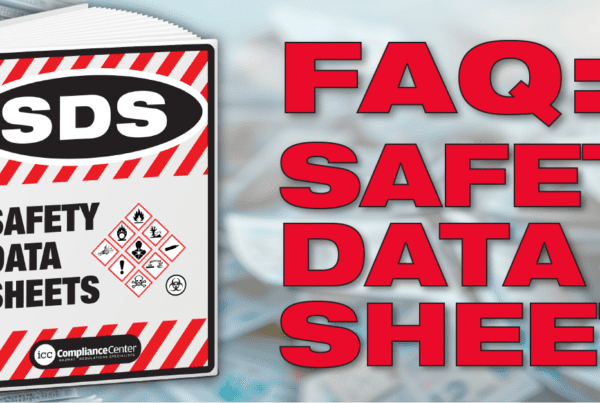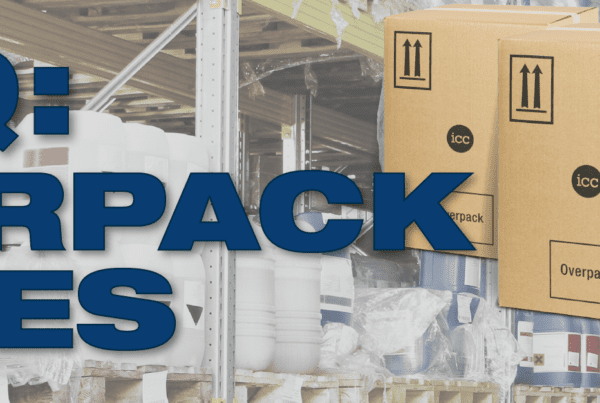Frequently asked questions regarding labels and labeling requirements.
How should the hazard label be applied to my shipment?
TDG requirements for small means of containment when shipping by road, rail, marine, and air domestic flights (for marine and air domestic, also see the IMDG Code and ICAO requirements respectively):
- On any side of outer surface other than the side on which it is intended to rest or to be stacked during transport;
- visible and legible and displayed against a color contrasting background;
- made of durable and weather resistant material;
- respecting the specified color in the appendix of Part 4 of this Regulations;
- On or near the shoulder of a cylinder containing a dangerous goods;
- For class 7, on two opposites sides of the surface other than the side on which it is intended to rest or to be stacked during transport;
- A label that are reduced to 30 mm in length may be displayed on a tag that is securely attached to a small means of containment
- One label for primary class and one for subsidiary class, if Special Provision 16 appears in column 3 of Schedule 1;
- the oxidizer label must be used for the following non-flammable, non-toxic gases, with oxidizer subsidiary class: UN1072, UN1073, UN3156, UN3157;
- in transport by ship, the marine pollutants must be displayed next to the primary class label for the dangerous goods, or if there is a subsidiary class label, next to the subsidiary class label;
- the Category B mark must be displayed for infectious substances included in UN3373, Biological substances, Category B.
49 CFR requirements:
- one label printed on or affixed to a surface other than the bottom of the package or containment device;
- whether printed on or affixed to a package, must be durable and weather resistant; able to withstand, without deterioration or a substantial change in color, a 30-day exposure to conditions incident to transportation;
- located on the same surface of the package and near the proper shipping name marking;
- printed on or placed on a securely affixed tag or affixed by other suitable means to:
- a package which has dimensions less than those of the required label
- a cylinder
- a package having irregular surface not allowing to affix satisfactorily a label
- for class 7, radioactive material, each package requires to be labeled with two radioactive labels, affixed to opposite sides of the package;
- if primary and subsidiary hazard labels are required, they must be displayed next to each other. The placement is conform if the labels are within 150 mm (6 inches) of one another;
- printed on or affixed to a background of contrasting color or must have a dotted or solid line outer border;
- duplicate labels must be displayed on at least two sides or two ends, other than the bottom of:
- each package or overpack having a volume of 1.8 m3 (64 cubic feet) or more;
- each non-bulk package containing a radioactive material;
- each DOT 106 or 110 multi-unit tank car tank. Labels must be displayed on each end;
- each portable tank of less than 3,785 L (1000 gallons) capacity;
- each freight container or aircraft unit load device having a volume of 1.8 m3 (64 cubic feet) or more but less than 18 m3 (640 cubic feet). One of each required label must ;be displayed on or near the closure;
- an IBC having a volume of 1.8 m3 (64 cubic feet) or more.
- must clearly visible and may not be obscured by markings or attachments;
- except for materials poisonous by inhalation, a label conforming to specifications of the UN Recommendations may be used;
- the marine pollutant mark must placed in association with the hazard warning labels:
- for bulk packaging, the marine pollutant mark on at least two opposing sides or two ends other than the bottom if the packaging has a capacity of less than 3,785L (1000 gallons). If the mark has the dimension of a placard, it may be displayed in black lettering on a square-on-point configuration; the mark must visible from the direction it faces;
- if the package has a capacity of 3,785L(1000 gallons) or more, the package must be marked on each end and each side, visible from the direction it faces, displayed in black lettering on a square-on-point configuration, if the mark has the dimension of a placard;
- the oxidizer label modified to display the word “OXYGEN” and the class number 2, must be used for a package containing Oxygen, compressed, or Oxygen, refrigerated liquid.
IATA requirements (international shipments):
- on the same surface of the package near of the Proper Shipping Name marking;
- affixed adjacent to the shipper’s or consignee’s address appearing on the package;
- when labels identifying primary and subsidiary risks are required, they must be affixed adjacent to each other;
- when there is no indication of a subsidiary risk in column D, the special provisions in column M may also require or exempt a subsidiary risk label;
- affixed at an angle of 45° (diamond shape) unless the package dimensions do not allow adequate space for this shape;
- securely affixed or printed on the packaging;
- readily visible and legible and not obscured by any other items or markings;
- affixed or printed on color contrasting background or must have a dotted or solid line outer boundary;
- must not be folded or affixed in such a manner that parts of the same label appear on different faces of the package;
- if label cannot be attached or printed on a surface because of package’s irregular shape, it is acceptable to attach the label(s) to the package by means of strong tag(s);
- the environmentally hazardous substance mark must be located adjacent to the other marks required by this Regulations;
- Cylinders for class 2 may, on account of their shape, orientation and securing mechanisms for transport, bear labels representative of those specified in this Regulations, which have been reduced in size according to ISO 7225:2005, for display on the non-cylindrical part (shoulder) of such cylinders. Those labels and the numbers appearing on them shall remain fully visible and the symbols recognizable;
- Salvage packagings’ must be labeled with all appropriate labels for the dangerous goods contained therein;
- One hazard label is required on the package for each class or division of dangerous goods contained within the same outer packaging.
IMDG Code requirements—provisions are related essentially to danger labels:
- shall be affixed for the hazard shown in column 3 of the Dangerous Goods List of this Regulations;
- a subsidiary risk label shall also be affixed for any risk indicated by a class or division number in column 4 of the Dangerous Goods List of this Regulations;
- when there is no indication of a subsidiary risk in column 4, the special provisions in column 6 may also require or exempt a subsidiary risk label;
- Be located on the same surface of the package near the Proper Shipping Name marking, if the package dimensions are adequate;
- Be so placed on the packaging that it is not covered or obscured by any part or attachment to the packaging or any label or marking;
- Primary and subsidiary risk labels are required to be displayed next to each other;
- Packages or irregular shape or small size that a label cannot be satisfactorily affixed, the label may be attached to the package by a securely affixed tag or affixed by other suitable means;
- Intermediate bulk containers (IBCs) of more than 450L capacity and large packaging’s shall be labeled on two opposing sides;
- An explosive subsidiary risk label, division 1.1 must be applied for type B self-reactive substances;
- The class 5.2 label shall be affixed to packages containing organic peroxides classified as types B, C, D, E or F. In addition the following subsidiary risk labels shall be applied:
- For organic peroxides type B, the explosive subsidiary risk label division 1.1;
- If packing group I or II criteria of class 8 are met, the corrosive subsidiary risk label.
- Any other label required by the nature of the content for the infectious substances in addition to the primary risk label class 6.2;
- Each package, overpack, and freight container containing radioactive material shall bare at least two labels affixed to two opposites sides on the outside of the package/overpack, or on the outside of all four sides of the freight container.
- Be placed in the form of a square set at an angle of 45o (diamond shape)
- Displayed on a background of contrasting colour, or shall have either a dotted or solid outer boundary line;
- Be reduced in size for packages of irregular dimensions which cannot bear required dimension;
- Cylinders for class 2 may, on account of their shape, orientation and securing mechanisms for transport, bear labels representative of those specified in this Regulations, which have been reduced in size according to ISO 7225:2005, for display on the non-cylindrical part (shoulder) of such cylinders. Those labels and the numbers appearing on them shall remain fully visible and the symbols recognizable;
- The methods of affixing labels or applying stencil(s) of label(s) on packages shall be such that the stencil(s) or label(s) will be identifiable on packages surviving at least three months immersion in the sea.
If I have an inner container that is labeled and placed inside a box, does the box require labeling?
Yes. This applies to all regulations.
Can I use the same hazard label when shipping to/from Canada and the USA?
TDG requirements: To Canada from other places, yes, until the final destination, if the hazard label is in conformity with other regulations.
IATA requirements: Labels required by other international or national regulations are permitted in addition to the labels required by these Regulations, but they cannot be confused with or conflict with.
49 CFR requirements:
- a package labeled in conformance with the TDG Regulations is accepted;
- a label conforming to the TDG Regulations specifications for a Class 2.3 and 6.1, if the package is transported in a closed vehicle or freight container. The package must be marked with the words “Inhalation Hazard” in association with the required labels;
- the “Inhalation Hazard” words on a label or in association with must be on two opposing sides of a bulk packaging.





